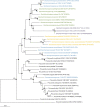Taxogenomic and Comparative Genomic Analysis of the Genus Saccharomonospora Focused on the Identification of Biosynthetic Clusters PKS and NRPS
- PMID: 33776952
- PMCID: PMC7990883
- DOI: 10.3389/fmicb.2021.603791
Taxogenomic and Comparative Genomic Analysis of the Genus Saccharomonospora Focused on the Identification of Biosynthetic Clusters PKS and NRPS
Abstract
Actinobacteria are prokaryotes with a large biotechnological interest due to their ability to produce secondary metabolites, produced by two main biosynthetic gene clusters (BGCs): polyketide synthase (PKS) and non-ribosomal peptide synthetase (NRPS). Most studies on bioactive products have been carried out on actinobacteria isolated from soil, freshwater or marine habitats, while very few have been focused on halophilic actinobacteria isolated from extreme environments. In this study we have carried out a comparative genomic analysis of the actinobacterial genus Saccharomonospora, which includes species isolated from soils, lake sediments, marine or hypersaline habitats. A total of 19 genome sequences of members of Saccharomonospora were retrieved and analyzed. We compared the 16S rRNA gene-based phylogeny of this genus with evolutionary relationships inferred using a phylogenomic approach obtaining almost identical topologies between both strategies. This method allowed us to unequivocally assign strains into species and to identify some taxonomic relationships that need to be revised. Our study supports a recent speciation event occurring between Saccharomonospora halophila and Saccharomonospora iraqiensis. Concerning the identification of BGCs, a total of 18 different types of BGCs were detected in the analyzed genomes of Saccharomonospora, including PKS, NRPS and hybrid clusters which might be able to synthetize 40 different putative products. In comparison to other genera of the Actinobacteria, members of the genus Saccharomonospora showed a high degree of novelty and diversity of BGCs.
Keywords: Saccharomonospora; actinobacteria; biosynthetic gene clusters; comparative genomic analysis; non-ribosomal peptide synthetase; polyketide synthase; secondary metabolites; taxophylogenomic analysis.
Copyright © 2021 Ramírez-Durán, de la Haba, Vera-Gargallo, Sánchez-Porro, Alonso-Carmona, Sandoval-Trujillo and Ventosa.
Conflict of interest statement
The authors declare that the research was conducted in the absence of any commercial or financial relationships that could be construed as a potential conflict of interest.
Figures







Similar articles
-
Epilithic Biofilms in Lake Baikal: Screening and Diversity of PKS and NRPS Genes in the Genomes of Heterotrophic Bacteria.Pol J Microbiol. 2018;67(4):501-516. doi: 10.21307/pjm-2018-060. Pol J Microbiol. 2018. PMID: 30550237 Free PMC article.
-
Antimicrobial Activity and Functional Genes of Actinobacteria from Coastal Wetland.Curr Microbiol. 2021 Aug;78(8):3058-3067. doi: 10.1007/s00284-021-02560-3. Epub 2021 Jun 22. Curr Microbiol. 2021. PMID: 34156543
-
Genome-based analysis of non-ribosomal peptide synthetase and type-I polyketide synthase gene clusters in all type strains of the genus Herbidospora.BMC Res Notes. 2015 Oct 9;8:548. doi: 10.1186/s13104-015-1526-9. BMC Res Notes. 2015. PMID: 26452464 Free PMC article.
-
Biosynthesis of hybrid peptide-polyketide natural products.Curr Opin Drug Discov Devel. 2001 Mar;4(2):215-28. Curr Opin Drug Discov Devel. 2001. PMID: 11378961 Review.
-
Discovery Strategies of Bioactive Compounds Synthesized by Nonribosomal Peptide Synthetases and Type-I Polyketide Synthases Derived from Marine Microbiomes.Mar Drugs. 2016 Apr 16;14(4):80. doi: 10.3390/md14040080. Mar Drugs. 2016. PMID: 27092515 Free PMC article. Review.
Cited by
-
Biosynthetic gene profiling and genomic potential of the novel photosynthetic marine bacterium Roseibaca domitiana.Front Microbiol. 2023 Sep 29;14:1238779. doi: 10.3389/fmicb.2023.1238779. eCollection 2023. Front Microbiol. 2023. PMID: 37860137 Free PMC article.
-
Diversity, molecular phylogenetics, and antibiotic biosynthetic potential of endophytic Actinobacteria isolated from medicinal plants in Nigeria.Braz J Microbiol. 2024 Mar;55(1):179-190. doi: 10.1007/s42770-023-01196-8. Epub 2023 Nov 30. Braz J Microbiol. 2024. PMID: 38030865 Free PMC article.
-
Genome-based reclassification of the family Stappiaceae and assessment of environmental forcing with the report of two novel taxa, Flexibacterium corallicola gen. nov., sp. nov., and Nesiotobacter zosterae sp. nov., isolated from coral and seagrass.PLoS One. 2025 May 15;20(5):e0322500. doi: 10.1371/journal.pone.0322500. eCollection 2025. PLoS One. 2025. PMID: 40373110 Free PMC article.
-
Phylogenomics of Haloarchaea: The Controversy of the Genera Natrinema-Haloterrigena.Front Microbiol. 2021 Oct 7;12:740909. doi: 10.3389/fmicb.2021.740909. eCollection 2021. Front Microbiol. 2021. PMID: 34690986 Free PMC article.
-
Phylogenomics reveals extensive misidentification of fungal strains from the genus Aspergillus.Microbiol Spectr. 2024 Apr 2;12(4):e0398023. doi: 10.1128/spectrum.03980-23. Epub 2024 Mar 6. Microbiol Spectr. 2024. PMID: 38445873 Free PMC article.
References
-
- Borriss R., Rueckert C., Blom J., Bezuidt O., Reva O., Klenk H.-P. (2011). “Whole genome sequence comparisons in taxonomy,” in Methods in Microbiology. Taxonomy of Prokaryotes, eds Rainey F., Oren A. (London: Academic Press; ), 409–436. 10.1016/B978-0-12-387730-7.00018-8 - DOI
LinkOut - more resources
Full Text Sources
Other Literature Sources
Molecular Biology Databases
Miscellaneous

